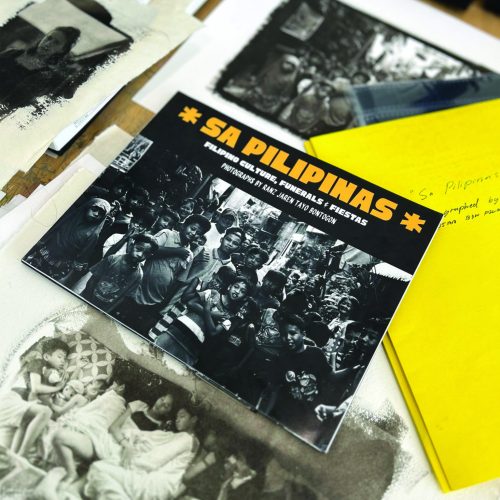
Ranz Jaren Tayo Bontogon, photographer for The Argosy and fourth-year Fine Arts student, is well-known at Mt. A. Skilled with film photography, proudly Filipino, and an overall positive spirit, Bontogon’s artistic skills culminate in a deeply personal project: a 132-page book of black-and-white film photos: Sa Pilipinas: Filipino culture, Funerals, and Fiestas. / Photographs of life in the Philippines.
Bontogon has lived in Canada for eleven years but grew up in Taguig, a city in Metro Manila. With the highest population density in the world, Bontogon describes his first home as a vibrant, tight-knit community. It is not in extreme poverty, “but a majority of the people back home are in the lower class. And since we are really densely populated, some people do not get a lot of support. The houses that are built back home are not as sturdy as [Canada]. But […] now I think people back home are doing great.”
Bontogon left the Philippines in 2013. Despite feeling welcomed, Bontogon was not immune to Canadian culture shock. Among new challenges, like language and food differences (Canada needs more Jollibee restaurants, he jokes), societal expectations like personal space are different. Bontogon remembers standing in line at Tim Hortons, confused when the man behind him asked for ‘more space’ while they waited to order. “It kind of makes sense: the whole country of Canada just is such a big country. Everybody has their own little space, but that is something I never had growing up.”
While a room to himself was a new privilege, Bontogon deeply longed for the intimacy of countless friends and relatives within arm’s reach. Growing up, six to seven– children might share a bed — and when taking the photo that opens the book’s ‘Pamilya/Family’ chapter, “my sister was right beside me, and we both cried. Because […] this is something that we miss.” In the photo, kids sleep with their arms around stuffed animals and each other. Comfortable, they share blankets, mattresses, and breaths.
This book began in December 2022, when Bontogon returned to the Philippines to care for his ill grandfather: his first visit home in ten years. Until that point, leaving Canada would jeopardize his Permanent Resident status. Bontogon applied for Canadian citizenship as soon as he could to travel home. Following this first trip, he returned to Canada to finish his third year of study in Mt. A’s Fine Arts program.
The funeral in this book is his grandfather’s. He died in the spring of 2023. This summer, Bontogon and his family returned to Taguig for the second time in as many years, but this time, Bontogon was prepared. With a thrifted CANON AE1 Program camera and about 50 rolls of black-and-white film, he explored his home, photographing life, honoring death, and every raw, beautiful moment in between.
“The whole book itself is an invitation into my home […] you have to experience [Filipino culture] for yourself, but it is like a window; a scratch on the surface.”
Every photo in the book has a story, a puzzle piece that makes up Bontogon’s vibrant and complex heritage. Children boxing on the street hug, grin, and pummel each other (this is so common, Bontogon shares, that you can find this exact street on Google Maps – and see the same children playing with their gloves). In another photo, two students hitch a ride on the back of a jeepney. Those vehicles are named like boats: this one, ironically, is called ‘2 Brothers’.
Bontogon’s favourite photo is the cover: Canada has an assumption of privacy, but “when Filipinos see a camera, […] it is the other way around. […] I started taking a photo of just this one kid. And then the other kid yelled, ‘this guy has a camera! Come over! Come over! […] one thing led to another and I took a photo of a whole community.”
Monochrome film for Bontogon is timeless, honest, and straightforward, intimately portraying the complex reality of Filipino life until the book’s last chapter. “‘Festival’ is meant to be really colorful,” he shares, and following the previous “Funeral” chapter, “I wanted it to have a happy ending”. There are seven chapters in total: “Countryside”, “Food”, “City”, “Community”, “Family”, “Funeral”, and “Festivals”. Each has an introduction, written by Bontogon, providing life stories and knowledge.
This book is triumphant for Bontogon, both as a project, but also as a reflection of his identity. “My whole life, I have adjusted myself for other people. I have to adjust myself for them because they do not really know where I am from […] they acknowledge my existence but I feel that is about it. But my hope for this is to break that cultural barrier, so we can understand each other more deeply. […] this is my attempt to represent my country.”
Between each photo, and since returning to Canada, life goes on. Bontogon cites Heraclitus, ‘It is not possible to step into the same river twice’. “Once you have crossed time, you can never go back. […] but that is the beauty of photography. You preserve moments.”
A Marjorie Young Bell grant funded the development of Sa Pilipinas. Bontogon plans to sell the photobook in local stores, where book sales will fund further printing and artistic projects. Sa Pilipinas will also be available to order directly through Bontogon for $25 beginning early April. To stay up-to-date, follow @ranz_jaren.exe on Instagram or visit his website: www.ranz-bontogon.com





